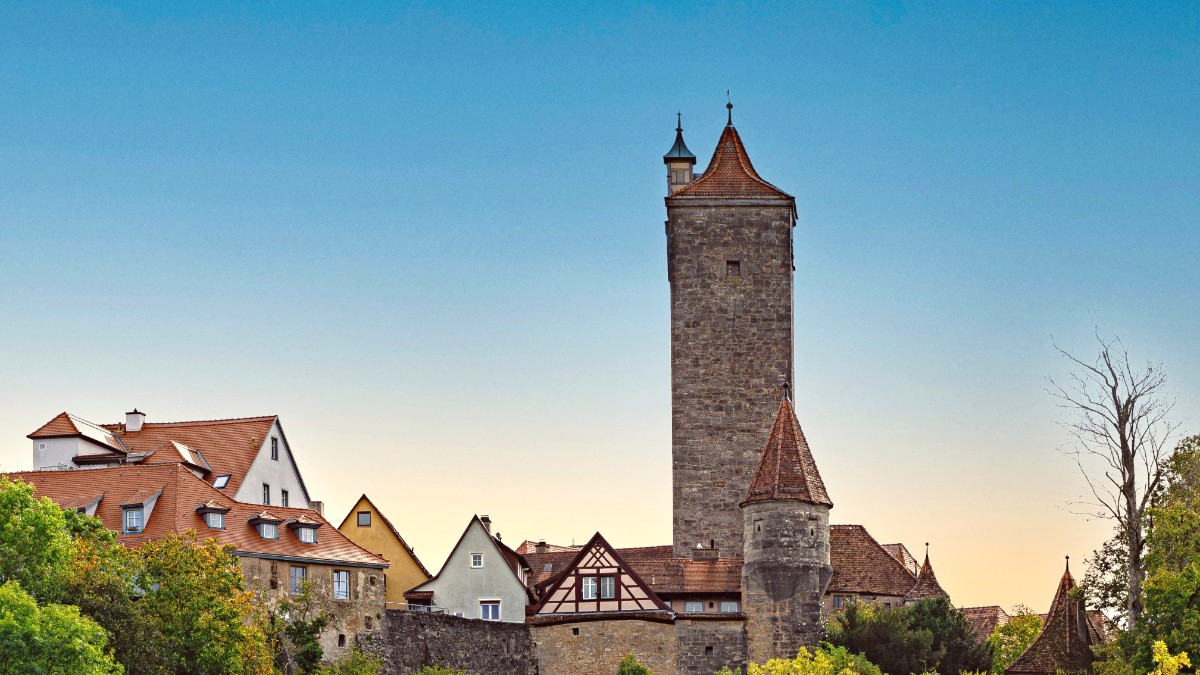
Bavaria, Germany
Franconian cuisine developed from simple, farm-to-table ingredients, emphasizing sustainability and utilizing local produce, meats, and grains. Historically, the dishes offered sustenance for a working population. This culinary heritage results in a cuisine that is robust, flavorsome, and satisfying. In Rothenburg, the focus remains on these time-honored recipes, featuring an authentic taste of the past.
Pork is a prominent meat, appearing in various forms like Bratwurst. Potatoes are a staple, served boiled, roasted, or as dumplings. Cabbage, especially Sauerkraut, accompanies many meals. Fresh bread and rolls join every meal. Seasonal local vegetables and fruits like apples and plums are common.
Flavors are savory and rich, often with herbs like caraway, marjoram, and parsley. A balance of sweet and sour notes often present in dishes with cabbage or fruit sauces. Roasting, stewing, and slow-cooking methods are common, bringing out deep, comforting tastes.
Breakfast (Frühstück): 7 AM - 10 AM. Lunch (Mittagessen): 12 PM - 2 PM (often the main meal). Coffee & Cake (Kaffee und Kuchen): 2 PM - 5 PM. Dinner (Abendessen): 6 PM - 10 PM, often lighter than lunch.
Within Rothenburg ob der Tauber, the culinary focus remains strongly on Franconian specialties. While Bavaria as a whole has diverse regional dishes, Rothenburg showcases the specific tastes of its immediate area.
Rothenburg's most famous pastry. This unique dessert has shortcrust pastry strips rolled into a ball, deep-fried, and then dusted with powdered sugar. You also find variations coated in chocolate, nuts, or cinnamon sugar.
Find them at numerous bakeries and confectioneries throughout the old town.
Smaller and thinner than the well-known Nuremberg Rostbratwurst, these savory pork sausages are a regional specialty. They are often served with Sauerkraut or potato salad and mustard.
Look for them at traditional restaurants (Gasthöfe) and butcher shops (Metzgereien).
This hearty dish features a roasted pork shoulder, known for its incredibly crispy crackling. It comes served with a rich gravy and potato dumplings (Knödel).
Many traditional Franconian restaurants offer this dish.
A regional specialty, especially in autumn and winter when carp is in season. It is often fried until crispy or baked.
A savory tart topped with a creamy filling of onions and sometimes bacon. This dish often appears in autumn, paired with Federweißer (new wine).
While Rothenburg mainly focuses on traditional German cuisine, some hotel restaurants have a more upscale dining experience. For example, the Restaurant Eisenhut, located within Hotel Eisenhut, has elegant settings and refined German dishes, often with a regional focus.
You will find numerous mid-range restaurants within the old town, serving traditional Franconian and German fare. These places offer a comfortable dining experience with a good selection of local dishes.
For quick and inexpensive meals, explore these local options.
The Marktplatz hosts a weekly farmers' market (Wochenmarkt) where you find fresh produce and local specialties. Rothenburg has no large indoor food halls.
Check local schedules for market days.
International dining options are limited in Rothenburg. You find a few Italian restaurants or Asian eateries, but the town's culinary identity centers around its German and Franconian heritage.
For diverse international cuisine, consider a day trip to Nuremberg.
Many kitchens close in the afternoon between lunch and dinner.
In many traditional places, wait to be seated.
Menus often in German and English, but German phrases are welcome.
Some historic buildings may have stairs or uneven floors.
Awareness of gluten-free (glutenfrei) and other allergens is growing in Germany. Many restaurants can meet requests if you communicate clearly.
Carry a translation card for specific allergies.
Halal and Kosher options are very limited in Rothenburg ob der Tauber. It is best to plan to self-cater or bring appropriate snacks if these dietary needs are strict.
Pre-planning is for strict requirements.
Supermarkets outside the old town offer a wider range of specialty products for dietary restrictions. Consider bringing some of your essential snacks or ingredients if your needs are very specific.
Clear communication with restaurant staff goes a long way. Germans are generally polite and try to meet guest requirements, especially when clearly stated.
While formal classes are rare, some bakeries may offer informal demonstrations or insights into the making of Schneeballen if you express interest.
Opportunities for farm visits or tours of food producers are possible in the surrounding rural areas of the Tauber Valley, but these are not typically organized tourist activities directly from Rothenburg.
While Rothenburg itself does not have large breweries for tours, the Franconian region is rich with smaller breweries, some of which may be accessible for tours and tastings outside the town.
Dining in Rothenburg means experiencing meals within historic buildings, often with centuries of history. This creates an unique ambiance that enhances the culinary experience.
Many restaurants preserve traditional decor.
The combination of historic surroundings, local Franconian flavors, and traditional service makes for a truly memorable dining event.
A culinary journey through time.
While formal culinary tours are not standard, you can create your own by sampling various Schneeballen bakeries or tasting different Franconian sausages from butcher shops.
Visit the weekly market to purchase local cheeses, fresh fruits, and regional specialities directly from producers.
Head to a local wine shop to sample Franconian wines, especially the unique Silvaner grape bottled in the traditional Bocksbeutel.
Do not hesitate to ask staff for recommendations or for explanations of dishes on the menu. Most tourist-oriented restaurants have English-speaking staff.